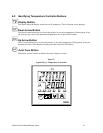Cabinet Series Dehumidifying Dryer 12
2-7 What is Desiccant?
Desiccant is a material which attracts and holds (absorbs) water from the air. Our dehumidifying
dryers use a synthetic crystalline metal aluminosilicate desiccant blended with a clay binder and
formed beads.
Absorbed water is driven from saturated desiccant by heating it to a high temperature (reducing
desiccant capacity to hold water) and forcing air through it. This moisture removal process is
called regeneration.
2-8 The Process/Regeneration Cycle
Our dehumidifying dryers have two desiccant beds. While one bed is on-line in the process air
loop, the other is off-line being regenerated.
When a desiccant bed is on-line, it absorbs moisture from the process air. In time, the bed
becomes saturated with moisture and needs to be regenerated. The dryer automatically redirects
the process airflow to the second bed and starts the regeneration cycle on the first bed.
During regeneration, the dryer heats air to over 500°F (260ºC) and forces it through the desiccant
bed. Moisture driven off the bed bleeds to the atmosphere.
If you measure the temperature of the air bled to the atmosphere (bleed temperature), you should
observe a rise after a period of time. This condition, bed breakthrough, indicates that the bed is
dry. At bed breakthrough, the bleed air temperature peaks between 350°F (176ºC) and 400°F
(204ºC).
The Dew Point meter measures the dew point of the process air. A properly regenerated bed
produces process air dew point of -40°F (-40ºC). This ultra-low humidity level is more than
adequate to dry plastics to as little as .003% moisture, depending on the process and material.
2-9 Specifying a Drying/Conveying System
Many variables were considered in the selection of your drying system, including type of
materials, residence time, throughput of the extruder or injection molding machine, ambient air
moisture and temperature, and the altitude at the processing site. If your operating environment
changes, the manufacturer can advise you on necessary equipment and process time and
temperature modifications required for your system.


















